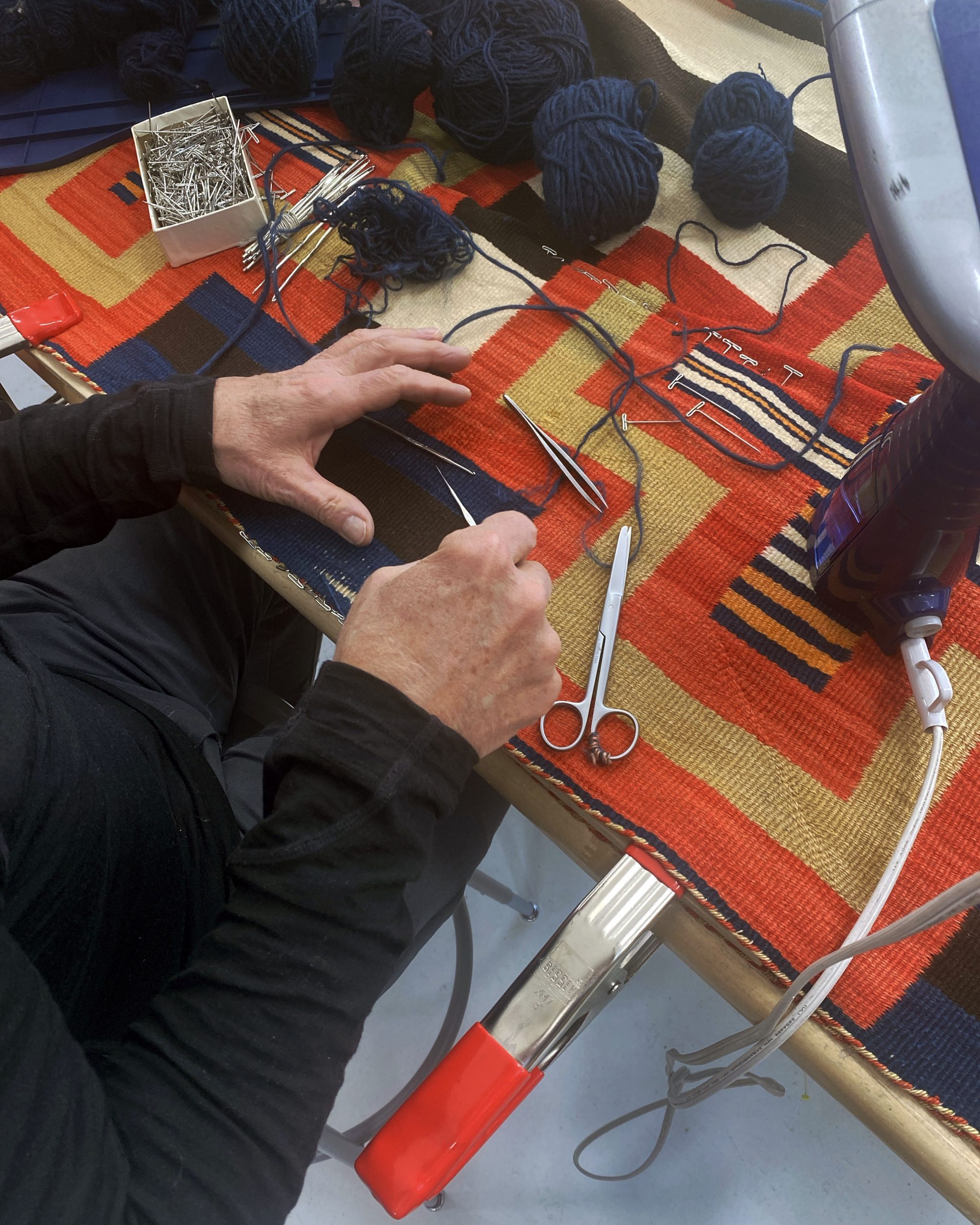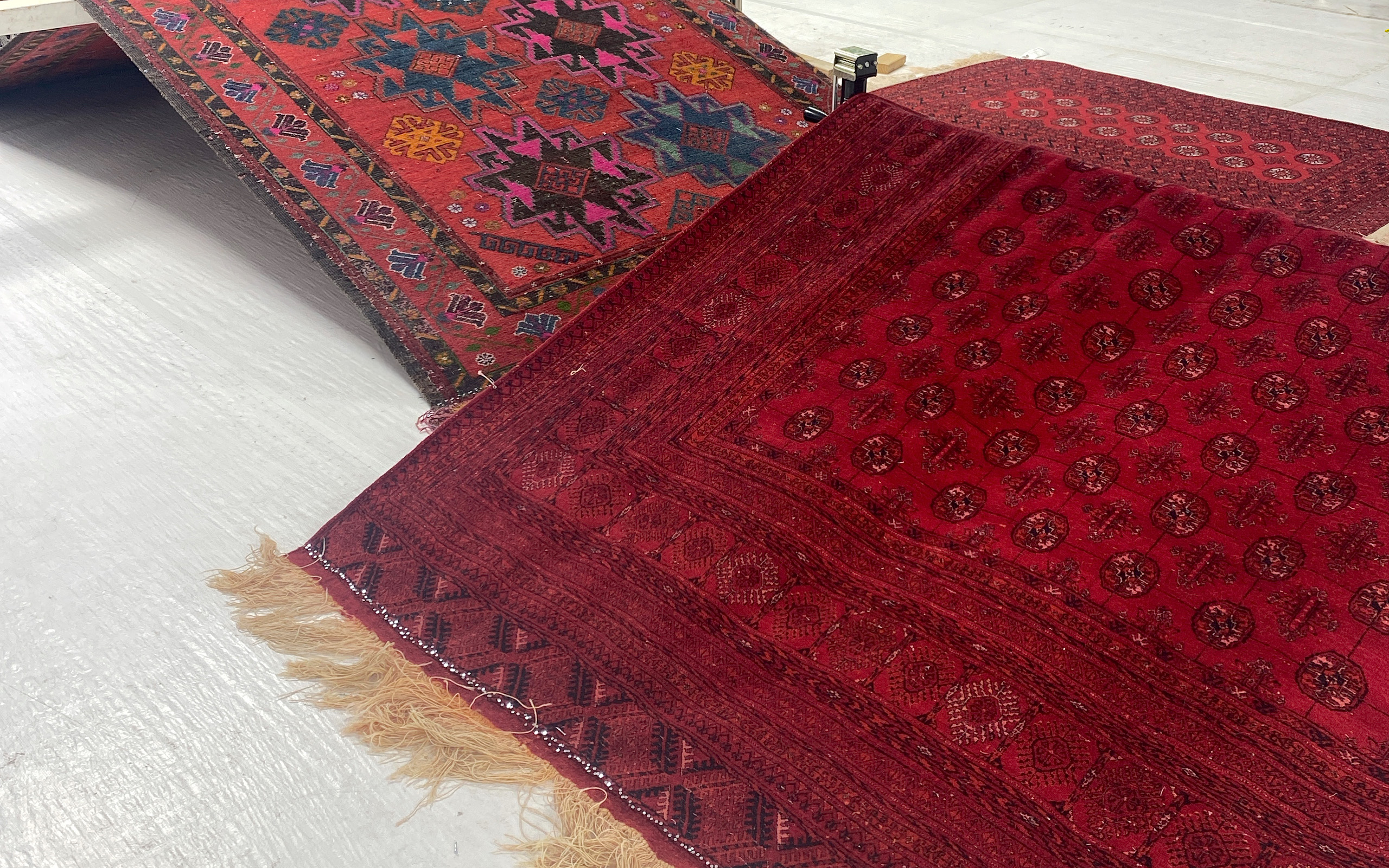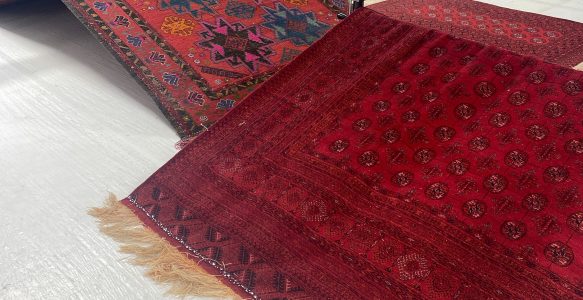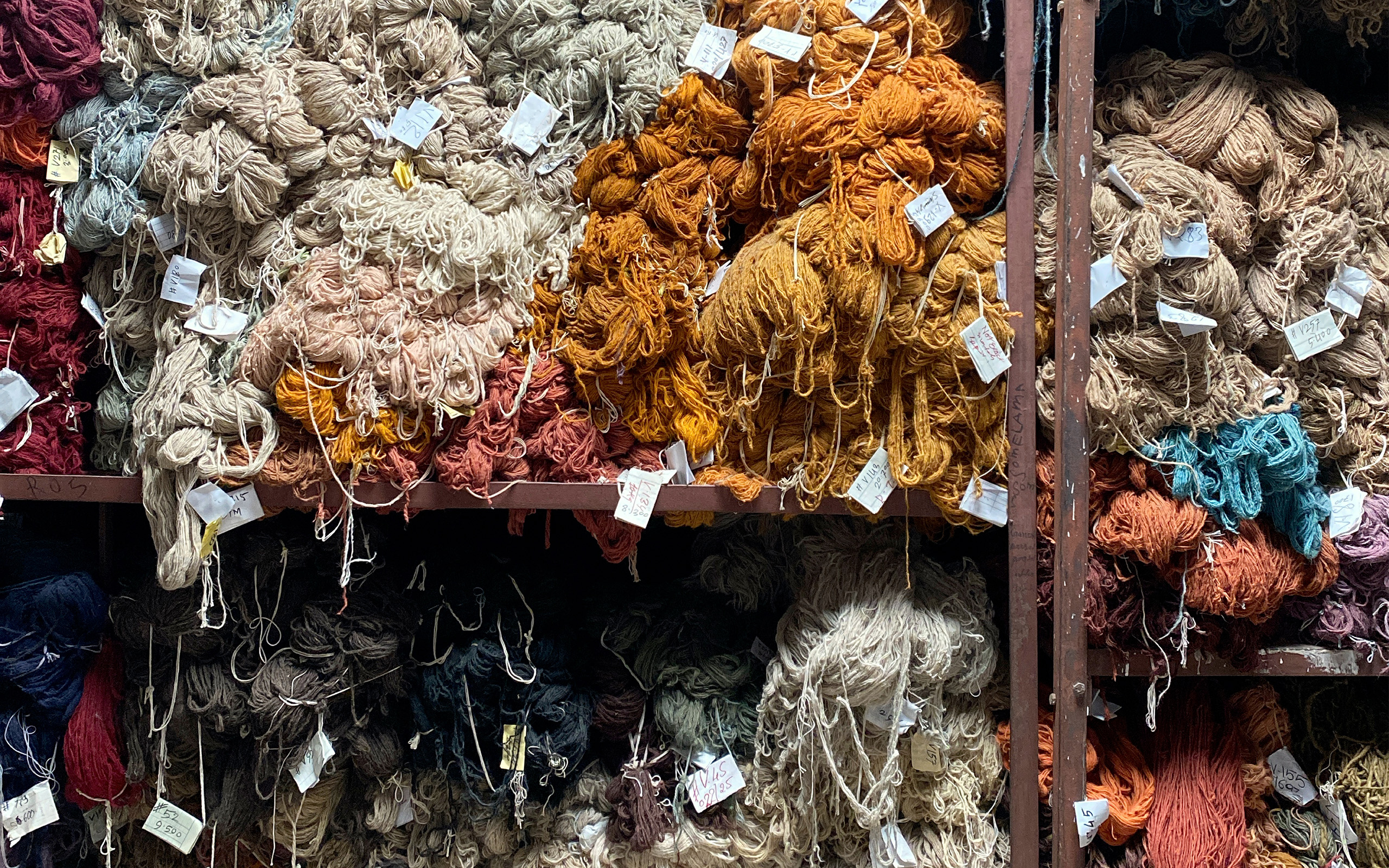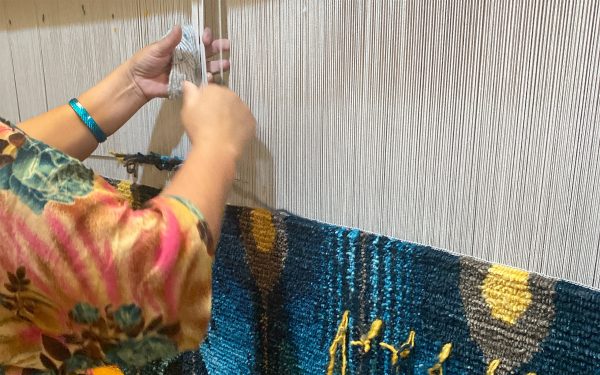These prepared remarks were originally presented to the Association of Rug Care Specialists (ARCS) during Rug-A-Paloosa at the world-class cleaning and rug repair facility of Robert Mann Rugs in Denver, Colorado, United States on Thursday, 3 November 2022.
Introduction
It was three years ago this month, November of 2019, that I found myself on a layover in Istanbul, en route to Kathmandu to finish work on a project with Econyl which saw the creation of the first handknotted carpet made from regenerated nylon. I was staying at the Turkoman Hotel, which for many of you more seasoned rug aficionados is undoubtably familiar. I was jet lagged – as I am this morning, my mind and body unsure exactly what time it was or was supposed to be. Groggy, with heavy eyes, and a slightly disheveled appearance, my only concern as I wondered into the rooftop dining room of the establishment was to find both coffee and sustenance. Thus, I was unaware of the exceptionally high concentration of anglophones in the room, when a voice said confidently, but with a bit of the interogative as though I too could not possibly be in Istanbul, ‘Michael Christie?’
Indeed it was me, I am Michael Christie, though perhaps you may know me by my nom de plume ‘The Ruggist.’ The voice which beckoned me from across the room before inviting me to join him for breakfast was that of Robert Mann who then also graciously extended an invitation for me to speak here today at Rug-A-Palooza. Well, not today actually for you see a pandemic (Perhaps you’ve heard of it?) repeatedly delayed this event until now. As it is, I could not be happier to be here, amongst fellow members of the rug and carpet industry, to share my thoughts and opinions on the state of the handknotted carpet trade. Thank you to Mr. Robert Mann for that invitation and thank you to the Association of Rug Care Specialists for having me here today.
I have thought of so many ways to begin this presentation and in fact have gone through several drafts in an attempt to distill what exactly is the state of the rug industry. When Robert asked me to speak three years ago I had a very clear picture of that in my mind, I had a certain career trajectory, and I was certain of the nature of the rug and carpet industry. Today, I must admit none of those things remain true in the ways they once were.
But first, just as in carpet making, we must construct the foundation of this presentation.
Foundation
Dominating my thoughts since March of 2020 when the pandemic first disrupted our lives, has been an attempt to understand the existential questions I had more than enough time to ponder during those periods of lockdown and isolation. Was I essential? What does being an essential worker even mean? What will the new normal look like? Now of course I must admit that because I am a man of a certain age, there is a strong affinity for existential dread, so do keep that in mind. But I believe, because these are my words so of course I believe them, that we can do no greater service to ourselves, nor to humanity than to ask these questions. In truth, we should question everything. Not as though we are toddlers repeatedly asking why because we don’t yet understand the world, but rather asking why because perhaps what we think we know is not longer suited to the conditions of this era. Maybe they were fine for then, but this is now. And moveover, the future is calling.
So I asked those questions about myself, my work as Editor of Rug Insider Magazine and by extension trade media broadly. And of course I also asked this of the mechanizations of the rug and carpet trade proper. For some the answers were obvious. I resigned as Editor of Rug Insider because I truly began to question the purpose of trade media, acting as it tends to as nothing more than a hopefully, though not always, glossy public relations firm for the Western portion of the rug and carpet trade. For other questions, the answers have been more elusive and, to the point of this presentation, they are often based on our individual and collective perspectives on the world of rugs and carpets.
That is what we are going to explore today. The state of the rug and carpet industry as seen through multiple lenses. To do that, I ask that you listen to my prepared remarks – I promise they will not become too belaboured – and then I likewise ask that you question me with your concerns and thoughts on the rug and carpet trade. It is only through the active exchange of information that we will be able to affect the real change needed for the rug and carpet trade, specifically that of handknotted carpets. So how did I come to question pretty much everything about the rug and carpet trade? I learnt to weave.
For those of you you follow me on Instagram you already know that I taught myself how to weave in the Tibetan style of weaving, but what you may not know is how I came to do this, and what I have truly learnt from the experience. I don’t recall exactly when, but the idea of learning to weave had been in my mind for years – at least since 2016 when I first traveled to Nepal. I had – as humans are prone to do – concocted an elaborate plan that would allow me to learn this ancient craft and fundamental technology of human civilization. I would take 6-8 weeks away from my normal life, travel to Kathmandu, sit with weavers, and learn the techniques from those who practice the craft of carpetry. But that was to be expensive, and time consuming, and so for both of those reasons and probably more, the plans never came to fruition.
Then came that aforementioned pandemic and the time to contemplate. One year into the pandemic, please do not ask why it took so long I do not know, I had an epiphany while reading ‘The Persian Carpet’ by noted rug dealer and scholar Dr. Hadi Maktabi. In short, if nomads in a desert, could, millenia ago, with relatively limited resources figure out how to weave both fabric and rugs, then I, as a North American in 2022, with comparativly unlimited resources such as access to a hardware store, the internet, and the ability to Facetime with colleagues in Nepal, should be able to do the same thing. So I did. Not to dwell on this for I can easily do as such, but learning to weave and moreover continuing to weave as craft, as art, as meditative practice has easily been one of the most consequential things I have ever done in my life. Why? Because it taught me the value of perspective and – at least in some small way – allowed me to imagine the role of the weaver in the modern production environment.
It is this notion of perspective which influenced the title of this presentation. As a question, exclaimed in near disbelief, I want to scream…
(K)not Again!?
This is a transformative period for the industry broadly, but specifically and perhaps more so for handknotted production. We’re in the the gloaming of what has been an exceptional half century for carpetry which has enriched many, created many beautiful – and not – carpets, and also moved carpet making closer to the modern era. Already transformed have been the ways carpets are designed and traded, yet while modernization has occurred in some ways, production remains a bit anachronistic. As a labour intensive, though I do no believe difficult craft, handkotted carpet making has historically depended upon relatively inexpensive labour to create objects of decorative beauty that can be sold at consumer prices projecting the air and mystique of luxury.
But none of this exists in a vacuum. The state of the world today is such that we can no longer accept the status quo. Domestic and geopolitical instability and its inextricably linked economic uncertainty, climate change, wealth inequality, shifting consumer demographics, a nascent resurgent rise in worker rights, just to name a few, all affect the rug industry. Smart people, try to discern what all of that means. I am not certain I am so smart.
To the political I shall defer commentary as to avoid, well, politics, however to the other areas of concern I offer the following thoughts.
Economic Uncertainty
As people of privilege we view economic uncertainty far differently than those who craft the rugs and carpet we so love. End consumers of these luxury wares are often insulated from the harsh realities their decision to or not to purchase may create and while I am in no way discounted the effect decreased purchasing power can have to this demographic, for those in producing countries, there is simply not an understanding of the degrees of wealth involved. I myself am not in any way wealthy by Western standards, but let us not kid ourselves. I live an exceedingly comfortable life and have so many carpets in my home that I now hang them on walls – as any proper rug aficionado would – not because they are precious per se, but because there is no more room on the floor. But I digress. Likewise, when I am in Nepal, everyone who sees me walking down the road dressed in casual business attire, knows I have money because, in truth, I have more money than them. The disconnect, the failure to understand each other in this regard only exacerbates the situation when the system buckles and strains under external pressures.
So as it is now, in 2022 with the world’s economy doing, how shall we say this, unforeseen things. The potential impact to the rug industry is high. Will demand collapse? Will it spike? What will the rug consumer do? I don’t know. But I do know that if we buy fewer rugs, then those who depend upon the sales of rug and carpet to pay their daily wage and thus provide food and shelter will suffer. This is generally not the case for those choosing to forego a purchase. This economic uncertainty for workers causes them to consider other avenues of employment less dependent upon the luxury market.
Climate Change
I know what you are thinking, I thought you said you weren’t going to talk politics? I am not. Human caused climate change is real. The science is all but indisputable and we, as a society have been talking about it since the industrial revolution. But this time is different. There seems to be effort, even if only obligatory and half-hearted to make changes to our relationship with this, our only planet. By the way, if we had only one of something, something rare and potentially unique, perhaps akin to a highly collectable carpet, would we mistreat it? No. This is my logic regarding the earth and climate change.
We in the rug industry have the power to improve every aspect of the rug and carpet industry to create something actually sustainable, actually eco-friendly, actually symbiotic with this planet. Presumably thus lessening our impact on climate change. This should include not just so-called greenhouse gases but all aspects of carpetry which impact the environment. It’s a huge problem and, due to our perspectives and situations, rediculously inequitable both in harm and in remediation. As but only one examnple, yes, dye and wash facilities should be treating their effluent and reducing the use of harmful chemicals which affect both the earth and workers directly. Yet these are relatively expensive to construct. Our dispassionate interest here far removed from the production environment does not help. Instead, if we want luxurious handknotted carpets we need to parter more directly with those making carpets to build these facilities.
Wealth Inequality
Looking at this only briefly through the lens of those of us here in the priviledged occident, we must accept that the fewer people who have a degree of disposable income to choose to spend on luxury wares, the fewer luxury wares that can be sold. Certainly the exceptionally upmarket will hold its own, but the utilitarian origins of carpets invite them into so many homes. I consider this a driving force of the, wait for it, you knew it would be said, race to the bottom. If someone can no longer afford a handknotted carpet made of recherche natural materials, how about this cheap schlock instead?
This then touches back to climate change and the environment. As it stands now, cheap schlocky carpets are horrible for the environment. They are made of crap materials that as you all know are hard if not impossible to clean and they, owing to the nature of their manufacture, are largely incapable of being recycled. We don’t have it in our power to address the inequality of wealth, but we do have it within our power to craft aspiration wares, at accessible prices, that are truly earth friendly. One cannot fault those who either cannot or choose not to afford a handknotted carpet, opting in its stead for something less expensive, yet we can create that less expensive ware in far better ways.
Shifting Consumer Demographics
Throughout what in Nepal is called ‘The Golden Era,’ here in the West perhaps the ‘Modern Carpet Revolution’ – modern as in of this time, not the poorly defined aesthetic – carpets have been soold to what was the largest, and most well funded, consumer demographic ever: the baby boom generation. And thank goodness for them, they have in one way or another enabled all of to be here in this room together now. I do not believe the customer is always right, rather I believe they are never wrong, and moreover that they are the customer. Deference is required.
But the Baby Boom Generation is no longer our largest demographic cohort, because they are, to say in polite terms, passing into history. Now we must look to successive generations as our customers, and these are different they the ones of the past. Generation X, for which I am a member is of what I might consider rug buying age now, but the oft maligned Millenials are where I see great potential. It is now a larger demographic cohort than Baby Boomers and if we are to sell handknotted rugs in the future, we must encourage an affinity for this type of product, one in sync with the zeitgeist of this generation, so as to foster demand and thus sales.
Workers’ Rights
In 2016 I listened to Rob Leahy of Fine Rugs of Charleston give a presentation during Istanbul Carpet Week in which he predicted that in 5-10 years, tufted rugs would be considered high-end and handknotted would graduate solely to the domain of the couture. For some reason I envisioned that to be in the future and yet here we are now, in the future, and tufted rugs are pretty amazing I must say. Despite their relative lack of circular design which would enable them to be earth friendly. Again, I digress.
But what does this have to do with workers’ rights? Cost of and availability of labour?
Perhaps the single most discussed topic within the production and import segment of the rug trade. As labour cost have, over time, increased, the industry has sought ways to mitigate this. Either through shifting production to less expensive countries, or by adopting less expensive, more mechanized means of production. This we know.
At the same time we have workers who have laboured as weavers now being offered other employment opportunities as countries develop. China is a great example of this. There was, in a past century a huge number of carpets produced in China, yet as the country developed, as those who wove were able to afford education for their children, the willingness of people to work as weavers diminished. On one hand this is simply competition for relatively unskilled, minimum waged labour, on the other it is a now educated young person who has not only the ability, but the understanding that other options do exist for them. If the wages are the same, but weaving offers tedious – though I would not say hard – work in a hot, perhaps inadequately lit facility, with mediocre lodging, and another job offers comparatively easier work, in a more climate controlled environment, with bright lighting, and better accommodations, it does not take a doctorate to deduce where the worker will go. For the now educated person joining the workforce the dynamic is even more challenging. Why would someone, trained in whatever field, choose to work as a weaver if they could and do earn more elsewhere?
If this sounds eerily familiar it is because this is not a situation unique to carpetry. It’s playing out now here in North America as workers – who like me had time to question their role in the great economic churning of capitalism and which I in no way discount – now understand they do not necessarily have to labour in menial positions. Historically this has been remedied, such as it was, by shifting production from one more developed country, to another less developed country. There will come a time, when this is no longer possible.
I wonder, with the ever more connected world giving us increased access to information if that time may come sooner than we had anticipated.
In conclusion
We sell to the end consumer handknotted carpets as a luxury ware, and indeed they are for none of us need these carpets on our floors. Yet it remains such that the production and distribution is decidedly unglamourous and utilitarian, if not also slightly romantic – at least from the perspective of the person purchasing the rug who has potentially never laboured as hard as a weaver.
This returns me to my discomfort with trade press. When say the ‘rug and carpet industry’ we are typically speaking only of the supply chain from importer to end consumer, neglecting as it were the entirety of the portion of the industry that makes what is sold. It is of course hard to argue against this as trade press is beholden to their customers – advertisers – who are almost exclusively Western based. In this era, I think it is time we transform as to be ahead of the curve as to the needs of our future customers and weavers.
Moreover, we must treat weaving as it is, not as we imagine it to be. It has been said that the rug industry ‘preserves ancient techniques,’ which to some extent is true, yet where was our concern for those luddite weavers who feared the loss of their jobs to the mechanized looms of the industrial revolution. I feel our romantic view of the mystique of the handknotted carpet is at odds with both reality, and the authenticity that our future customers seek.
Finally, I think we must ask why does the existing traditional distribution model of the industry persist? Certainly there are complexities and challenges to flatenning the supply chain, yet it has happened in many other industries, and it is already happening to some extent here in rugs. More retailers/dealers are now going direct, because they can, and it is that the importer faces increases challenges of remaining both relevant and adding value. So long as there is value added I think a customer should be satisfied, but if all am importer has become is an order forwarder or agent, I wonder if that truly helps preserve weaving or existing business models. As someone who has built a career, such as it is, talking about and examining the trade of handknotted carpets, my only concern for my career is that carpets are made and sold. The specifics of that matter not.
I’ve watch, and listened to respected colleagues complain about greed in the industry, while simultaniously defending their piece of the metaphirical pie. Importers malign dealers who go direct, everyone except foreign exports malign those who sells rugs via Instagram or the internet, and everyone from the smallest manufactory owner dreams of making the same riches as those who sell at very high margins. In sum all this tells me is that the model no longer works for everyone and we should entertain new ideas, to craft amazing rugs, in tune to the needs of future generations. From weaver to end consumer, I imagine there are now, because circumstances have changed, other options which might allow higher wages to be paid to the weaver while simultaniously bringing the same or better calibre product to market at prices consumers are willing to pay.
Thank you once again for having me here today. Thank you for your time and attention. I shall now open the floor to questions.
